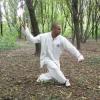CYBERMED LIFE - ORGANIC & NATURAL LIVING
CYBERMED LIFE - ORGANIC & NATURAL LIVING
 Tai chi (taiji), short for T'ai chi ch'üan, or Taijiquan (pinyin: tàijíquán; 太极拳), is an internal Chinese martial art practiced for both its defense training and its health benefits. The term taiji refers to a philosophy of the forces of yin and yang, related to the moves. Though originally conceived as a martial art, it is also typically practiced for a variety of other personal reasons: competitive wrestling in the format of pushing hands (tui shou), demonstration competitions and achieving greater longevity. As a result, a multitude of training forms exist, both traditional and modern, which correspond to those aims with differing emphasis. Some training forms of tàijíquán are especially known for being practiced with relatively slow movements.
Tai chi (taiji), short for T'ai chi ch'üan, or Taijiquan (pinyin: tàijíquán; 太极拳), is an internal Chinese martial art practiced for both its defense training and its health benefits. The term taiji refers to a philosophy of the forces of yin and yang, related to the moves. Though originally conceived as a martial art, it is also typically practiced for a variety of other personal reasons: competitive wrestling in the format of pushing hands (tui shou), demonstration competitions and achieving greater longevity. As a result, a multitude of training forms exist, both traditional and modern, which correspond to those aims with differing emphasis. Some training forms of tàijíquán are especially known for being practiced with relatively slow movements.
Today, tai chi has spread worldwide. Most modern styles of tai chi trace their development to at least one of the five traditional schools: Chen, Yang, Wu (Hao), Wu and Sun. All of the former, in turn, trace their historical origins to Chen Village.
Tai chi has been reported as being useful in treating a number of human ailments, and is supported by a number of associations, including the National Parkinson Foundation and Diabetes Australia. However, medical evidence of effectiveness was lacking and in recent years research has been undertaken to address this. A 2017 systematic review found that it decreased the risk of falls in older people.
A 2011 comprehensive overview of systematic reviews of tai chi recommended tai chi to older people for its various physical and psychological benefits. There was no conclusive evidence of benefit for any of the other conditions researched, including Parkinson's disease, diabetes, cancer and arthritis.
A 2015 systematic review found tai chi could be performed by those with chronic medical conditions such as chronic obstructive pulmonary disease, heart failure, and osteoarthritis without worsening shortness of breath and pain, and found favorable effects on functional exercise capacity in people with these conditions.
In 2015 the Australian Government's Department of Health published the results of a review of alternative therapies that sought to determine if any were suitable for being covered by health insurance; t‘ai-chi was one of 17 therapies evaluated and the conclusion was that there is very-low-quality evidence to suggest that tai chi may have some beneficial health effects when compared to control in a limited number of populations for a limited number of outcomes.